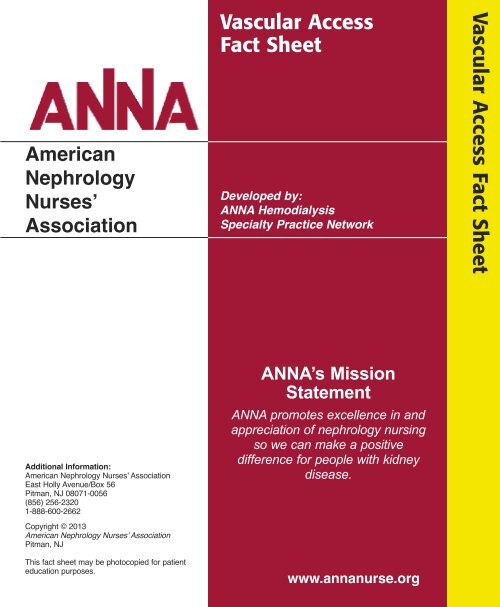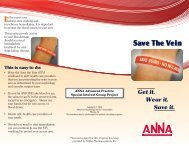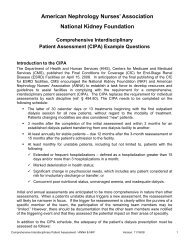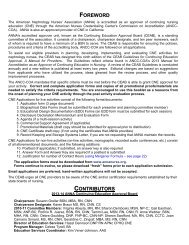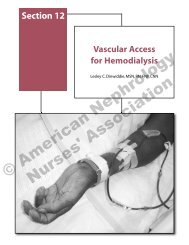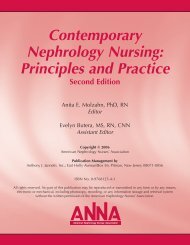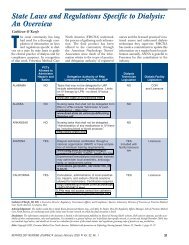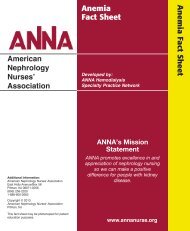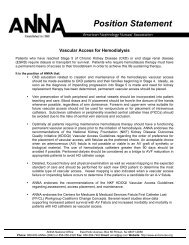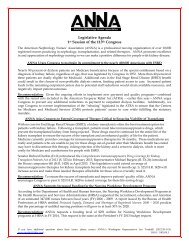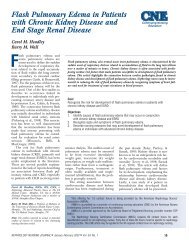Vascular Access Fact Sheet - American Nephrology Nurses ...
Vascular Access Fact Sheet - American Nephrology Nurses ...
Vascular Access Fact Sheet - American Nephrology Nurses ...
Create successful ePaper yourself
Turn your PDF publications into a flip-book with our unique Google optimized e-Paper software.
<strong>American</strong><br />
<strong>Nephrology</strong><br />
<strong>Nurses</strong>’<br />
Association<br />
<strong>Vascular</strong> <strong>Access</strong><br />
<strong>Fact</strong> <strong>Sheet</strong><br />
Developed by:<br />
ANNA Hemodialysis<br />
Specialty Practice Network<br />
<strong>Vascular</strong> <strong>Access</strong> <strong>Fact</strong> <strong>Sheet</strong><br />
Additional Information:<br />
<strong>American</strong> <strong>Nephrology</strong> <strong>Nurses</strong>’ Association<br />
East Holly Avenue/Box 56<br />
Pitman, NJ 08071-0056<br />
(856) 256-2320<br />
1-888-600-2662<br />
Copyright © 2013<br />
<strong>American</strong> <strong>Nephrology</strong> <strong>Nurses</strong>’ Association<br />
Pitman, NJ<br />
This fact sheet may be photocopied for patient<br />
education purposes.<br />
ANNA’s Mission<br />
Statement<br />
ANNA promotes excellence in and<br />
appreciation of nephrology nursing<br />
so we can make a positive<br />
difference for people with kidney<br />
disease.<br />
www.annanurse.org
I. Overview<br />
Before beginning hemodialysis, a patient will need to have a vascular access in place. The vascular<br />
access will allow entry into the patient’s bloodstream. The access will allow the patient’s blood to<br />
travel to the dialysis machine so toxins, wastes, and extra fluid may be removed before returning the<br />
blood back to the patient. There are three types of vascular accesses: the arterio venous fistula (AVF),<br />
the arterio venous graft (AVG), and the central venous catheter. Each access requires a surgical procedure.<br />
<strong>Vascular</strong> accesses can be placed in the arms, legs, neck, or chest.<br />
A vascular access should be placed well in advance to beginning dialysis so the access will be ready.<br />
A fistula or graft will require 4 to 12 weeks to mature prior to the first use. A fistula can be accessed<br />
earlier depending on rate of maturation, but it requires an order from the nephrologist or surgeon<br />
before accessing. A person who has sudden kidney failure that will require immediate dialysis will<br />
have a central catheter placed for dialysis. The catheter will be used until an AVF or AVG can be<br />
placed and is ready for use. The catheter should always be the last access option. In some cases, a<br />
catheter may be the permanent access for dialysis.<br />
II. Arterio Venous Fistula (AVF)<br />
An AVF is created surgically by connecting an artery and a vein, and is usually placed in the arm. As<br />
the AVF matures, the vein will grow bigger and stronger from the blood flow of the artery. The fistula<br />
can provide good blood flow for many years of dialysis. Recent studies have shown that patients<br />
with AVFs have the least amount of complications, such as infections or clotting. Not everyone may<br />
be able to have an AVF placed due to weak veins or arteries, or other medical conditions. This is a<br />
discussion that the physician should have with the patient. The patient should ask for a fistula first.<br />
The fistula is considered the “gold standard” access:<br />
• Lower risk of infections than other types of access.<br />
• Lower risk of clotting than other types of access.<br />
• Better performance than other types of access.<br />
• Better blood flow rates.<br />
• Longer lasting.<br />
• Can be used for many years.<br />
III. Arterio Venous Graft (AVG)<br />
The AVG is similar to a fistula but has a manufactured tubing that connects the artery and the vein<br />
together. The graft is a soft material that is made from a type of Teflon ® or Gore-Tex ® . Transplanted<br />
animal or human vessels may be used as grafts to connect an artery and vein. The arm is the preferred<br />
site for a graft, but the leg can also be used for graft placement. An AVG made of polytetrafluoroethylene<br />
(PTFE) can be used in 14 days provided there is no edema. The manufacturer states<br />
that a vectra graft can be utilized 24 hours after insertion; however, there have been issues.
IV. Caring for a Fistula or Graft<br />
Good fistula or graft care will help maintain the patency of the vascular access. There are measures<br />
that can be taken to prevent clotting or infection to the access. Feel the “thrill” or vibration of blood<br />
through the access, or use a stethoscope to listen to the “bruit” or “whoosh” of blood through the<br />
access and site rotation.<br />
The access should be kept clean and free of injury. Inspect the access for signs of infection, including<br />
pain, tenderness, swelling, and redness to the area. Infections are treated with antibiotics. The access<br />
should be washed carefully before each dialysis session. The access site will need to be cleansed<br />
according to the facility protocol to prevent infection.<br />
The access needs to be protected from injury or restriction to prevent clotting of the access.<br />
• Avoid tight clothing, jewelry, or pressure on the access area.<br />
• Do not carry heavy objects across the access area.<br />
• Avoid lying on the access site when sleeping.<br />
• Do not allow blood to be drawn from the access arm.<br />
• Do not allow blood pressure to be taken in the access arm.<br />
Good needle sticks keep the access working well. The arterial and venous needle tips should be at<br />
least two (2) inches apart. The needles should not be placed near surgical scars. Assess the access<br />
to determine the location of previous needle sticks; this prevents tearing of the access. Needle stick<br />
sites should be at least one-fourth inch from previous sites. Some facilities now use the “buttonhole”<br />
technique for access cannulation. This method uses the same site for each dialysis session.<br />
There is a specialized training program for the patient and health care provider before using this<br />
method. Direct pressure is applied to the needle stick sites after each needle is removed.<br />
V. Central Catheters<br />
A catheter is a narrow, flexible tube that is used to access the blood stream. The catheter may be<br />
inserted into a large vein in the neck, chest, or groin. There will be two tubes exiting from the insertion<br />
site. One port allows for blood to be removed from the body, and the other port allows blood<br />
to return back into the body. Catheters are ready for immediate use after insertion. The catheter that<br />
is placed in the neck or chest will need to have internal placement confirmed by X-ray prior to use.<br />
Some patients use permanent catheters, but this is not the recommended access for long-term dialysis.<br />
• Catheters have a greater chance of becoming infected or clotting.<br />
• Catheters have a slower blood flow, thus not cleaning the blood as well.<br />
• Catheters are not the preferred choice of access for long-term dialysis.<br />
• Catheters can be used immediately after placement.<br />
• Catheters are at greater risk for central vein thrombosis or stenosis.<br />
• Catheters cause high risk for sepsis, hemorrhage, or air embolism.<br />
VI. Catheter Care<br />
The catheter exit site must be kept clean and dry. The patient will not be able to swim, take showers,<br />
or soaking baths. The patient will need to take care when bathing to not get the site wet. The<br />
catheter clamps must be clamped at all times when not in use. The ends of the catheter must have<br />
caps securely in place after each dialysis session. Theses measures will help to decrease the chance<br />
of infection and will avoid air from entering the vascular system. The exit site should be assessed<br />
with each dialysis session for signs of infection, including redness, swelling, pain, fever, or drainage
from exit site. The patient and health care provider should wear a mask every time the catheter<br />
is accessed to prevent microbes from the nose and/or mouth from contaminating the catheter<br />
or exit site. Always wash your hands and wear clean or sterile gloves when caring for the<br />
catheter. Blood draws from the catheter should be performed by dialysis personnel only; do<br />
not allow non-dialysis personnel to access catheter. Catheters should be placed as a bridge to<br />
dialysis while an AVF or AVG is healing. Sites preferred for tunneled catheter insertion are the<br />
right internal jugular or the right external jugular. Non-tunneled catheters (tem p orary catheters<br />
that do not have an internal cuff) should be used only when use will be less than 3 weeks.<br />
Placement sites are the same for tunneled and non-tunneled catheters. Catheters placed by<br />
radiology under fluoroscopy do not require a chest X-ray prior to use.<br />
Be careful not to pull or tug on the catheter. Scissors or other sharp objects should never be<br />
used near the catheter. Catheters may be positional, which means the catheter may work better<br />
when the patient is sitting in one position. Pay attention to what position works best for the<br />
patient so he or she achieves the best possible dialysis treatment. Should the catheter become<br />
dislodged or get pulled out, or bleeding occurs at the site, apply direct pressure to the site and<br />
proceed with the appropriate medical attention.<br />
Advanced Practice Nursing Care (Gomez, 2011) (in addition to the above items):<br />
1. Monitor the patient’s access by:<br />
• Reviewing dialysis laboratory values.<br />
• Reviewing dialysis adequacy.<br />
• Reviewing venous and arterial pressures.<br />
• Reviewing transonic flow rates.<br />
• Assessing vascular access complications (i.e. ischemia, infection, bleeding, thrombosis,<br />
inadequate flows, aneurysm).<br />
2. Educate patient about “saving the vein” or vein preservation for future access creation.<br />
3. Order diagnostic tests (i.e. fistulogram, duplex vascular scan of access) or laboratory values<br />
as appropriate. Consult physician as warranted based on results.<br />
4. Collaborate with nephrologist and/or formulate a vascular access team (i.e. APN,<br />
Nephrologist, <strong>Vascular</strong> Surgeon, RN, dialysis technician) to assist in evaluating the above in<br />
addition to having a plan of care for optimal dialysis access.<br />
5. Have a plan of action for future dialysis access if current access begins to fail or fails.<br />
VII. Resources<br />
Centers for Disease Control and Prevention (CDC). (2002). Guidelines for the prevention of<br />
intravascular catheter-related infections. Morbidity and Mortality Weekly Report (MMWR)<br />
Recommendations and Reports. Retrieved from http://www.cdc.gov/mmwr/PDF/<br />
rr/rr5110.pdf<br />
Centers for Medicare and Medicaid Services (CMS). (2005). Fistula first. Retrieved from<br />
http://www.cms.gov/Medicare/End-Stage-Renal-Disease/ESRDQualityImproveInit/<br />
downloads/FFFAQs.pdf<br />
Gomez, N.J. (Ed.). (2011). <strong>Nephrology</strong> nursing scope and standards of practice, 7th Edition.<br />
Pitman, NJ: <strong>American</strong> <strong>Nephrology</strong> <strong>Nurses</strong>’ Association.<br />
National Kidney Foundation. (2013). The National Kidney Foundation Kidney Disease<br />
Outcomes Quality Initiative (NKF KDOQI). Retrieved from http://www.kidney.org/<br />
professionals/KDOQI/guidelines_commentaries.cfm
Other Questions:<br />
For questions and/or concerns please contact us at _____________.<br />
For more information about nephrology nursing, dialysis, transplantation<br />
or other renal disorders check out the <strong>American</strong> <strong>Nephrology</strong><br />
<strong>Nurses</strong>’ Association (ANNA) Web site at www.annanurse.org.<br />
REV 2/13


